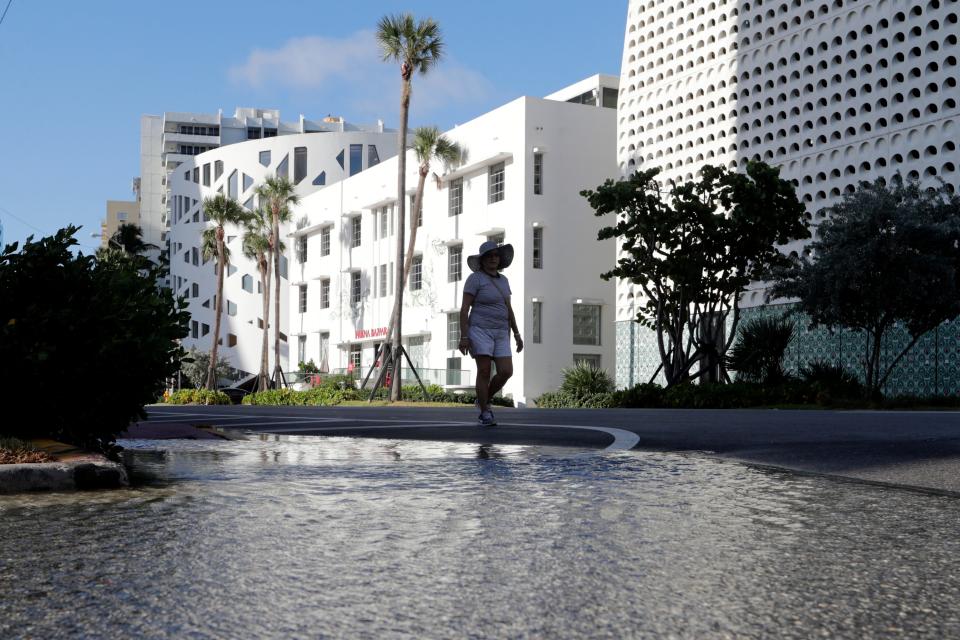Climate change produces positive and negative images in Florida, around the world
At a discussion about the United Nation’s Intergovernmental Report on Climate Change, held at Oak Hammock’s Institute for Learning in Retirement, one participant expressed his concern about climate activists overestimating what will occur during the next 40 years.
Another said the climate movement has “branded” climate change poorly. For example, not enough of the population empathizes with the polar bear. Perhaps we can find other ways to highlight the climate crisis.
Media outlets alerted many to the soaring temperatures in India and Pakistan. One headline said that Pakistan went from winter to summer, without spring. Both countries are experiencing extremely high temperatures causing heat-related health problems, failing crops and overloads on electricity.
But wait, those countries are half-way around the world. Can we empathize with people that far away?
Here in Florida, we are definitely experiencing rising seas. We all know the problems Miami Beach has had with eroding beaches, flooded roads and expensive redevelopment to higher ground. A map of Florida showing predictions of rising ocean water every 20 years could promote awareness.

But wait, Gainesville isn’t on the ocean. Most oceanfront homes are owned by wealthy people. How can we empathize with the rich?
In Miami, New Orleans and Norfolk, Virginia, many poor neighborhoods are built below flood zones. But can we empathize with the poor?
Florida also suffers from red tide, with heat increasing the likelihood of outbreaks. Our coral reefs are bleaching, dying in waters that have become too hot. The tourist industry suffers.
Rising waters and temperatures threaten Florida’s estuaries. There, young fish and crustaceans have always found shelter and safe places to grow. However, estuaries are now disappearing. The estuaries’ sensitivity to both the changes in the sea and land endangers its inhabitants, in turn imperiling the sport and commercial fishing industries.
More from Susan Nugent:
Protecting trees, promoting biodiversity in yards can help forestall climate change
Florida lawmakers have rejected legislation that would lead us to clean energy future
All Floridians will find their lives changed by rising and warming seas
One notable difference in Gainesville in the last 20 years is the climate-induced blight destroying dogwoods. They, along with many other plants, have failed to adjust to the increased heat.
With dogwoods we lose only beauty. Why should we care? Many food crops will not be able to adjust to the heat; others will blossom before seasonal pollinators are here; nectar and fruit needed by pollinators may no longer be available.
Both citrus farmers and home gardeners suffer losses. One orchard owner tells of fruit trees that have blossomed early and appear untouched by the later frosts, yet produced very few fruit. Possibly the pollinators weren’t around to pollinate in early January.
Another local friend is often affected by inland flooding. She lived in her home almost twenty years before the flooding started, following Hurricane Irma. Now, after heavy rains, her neighborhood entry road will be flooded. The county is presently working on drainage issues, including installing a pumping station, in her neighborhood.
We can also expect continuing influx and development. One fellow Climate Reality activist refers to herself as a climate refugee. She left Miami to move to higher ground, finding her new home here.
So how might we brand climate change in Gainesville? The dying dogwood? The rise in the price of oil? A fruitless tree? A flooded road? An additional sprawling construction to accommodate climate refugees? A dehydrated worker being loaded into an ambulance? A devastating hurricane? These are not pretty pictures.
As I drive away from my house, in front of me a home sports newly installed solar panels facing the street. I find myself smiling every time I see it. I don’t know the home owners but I applaud their recent decision to go solar.
For me, that act represents a hopeful change, action that addresses the threat. These homeowners are adapting to a changing world. In my mind, climate change can be rebranded by images like this home.

The results of positive actions can be seen everywhere: electric vehicles at charging stations; front yards covered with powder-pink mimosas for pollinators; battery-powered lawn mowers; butterfly gardens; drip irrigation systems; groceries packed in cloth bags; designated parking places for energy-efficient cars; orange and blue recycling bins; wildflowers in front yards and on roadsides; solar panels on roofs.
Keep these images in mind as we all work for a clean energy future.
Susan Nugent is a Climate Reality Project leader from Gainesville.
Join the conversation
Share your opinion by sending a letter to the editor (up to 200 words) to letters@gainesville.com. Letters must include the writer's full name and city of residence. Additional guidelines for submitting letters and longer guest columns can be found at bit.ly/sunopinionguidelines.
Journalism matters. Your support matters.
Get a digital subscription to the Gainesville Sun. Includes must-see content on Gainesville.com and Gatorsports.com, breaking news and updates on all your devices, and access to the eEdition. Visit www.gainesville.com/subscribenow to sign up.
This article originally appeared on The Gainesville Sun: Susan Nugent: Florida has many reasons to care about climate change

